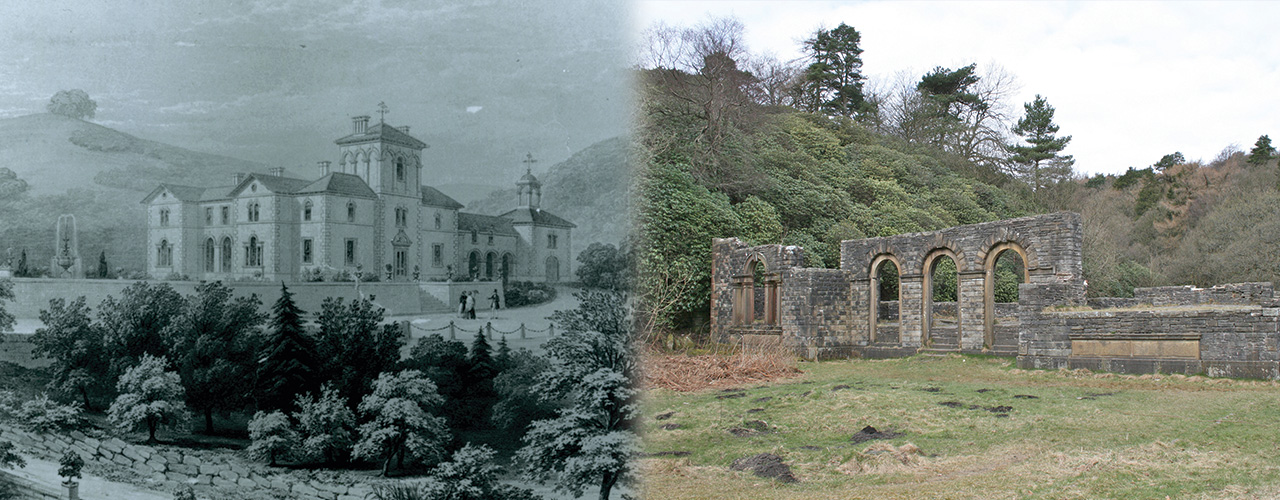
Goyt Valley timeline
This timeline shows the major cultural events in the valley’s history, including the arrival of the Grimshawe family who built Errwood Hall, to the construction of the two reservoirs which completely changed the landscape. Much of the information is taken from Gerald Hancock’s wonderful little book, Goyt Valley Romance, which is sadly now out of print. I’ll add more details as and when I discover them. And I’d be very grateful for any additional information anyone could provide. Please use the contact form to get in touch.
![]()
1831: Opening of the Bunsall incline on the High Peak Railway line which runs through the valley, joining the canals at Cromford and Whaley Bridge. Today, this forms the main way into the Goyt Valley from the Buxton to Whaley Bridge road.
1832 (9th April): Samuel Grimshawe (II) purchases the 2010 acre Errwood Estate from John William Jodrell for £9250. The contract states; “…the fee simple and inheritance free of Incumbrancces of and in the Goit’s head and Erwood Estates in Taxal called Erwood, Goits Bridge, Within Leach, Goits Clough, Castedge, the Cat & Fiddle public house, Gamekeeper’s House, dog kennels, etc.”
c.1840: Work starts on constructing Errwood Hall, overseen by Samuel’s son, Samuel Grimshawe (III).
1850: Samuel Arthur Grimshawe (IV) born at Errwood Hall.
1851: Samuel Grimshawe (II) dies aged 83, leaving the estate to his son. Samuel Grimshawe (III) converts to Catholicism.
1851: Samuel Arthur Grimshawe (IV) dies at Errwood Hall aged just one.
1851 (7th December): Birth of Samuel Grimshawe’s eldest daughter at Errwood Hall; Mary Ambrose Jemina Louisa.
1852: Birth of second daughter in Paris; Anne Genevieve Marie (known as Genevieve).
1860: Samuel Grimshawe donates £500 towards the cost of a new church in Stockport. And £100 towards the cost of St Anne’s Church in Buxton. Later that year, 7-year-old Genevieve Grimshawe lays the foundation stone at St Annes Church.
1870: Samuel Grimshawe purchases the Marquita, an ocean-going yacht.
1873 (6th September): ‘Coming of Age’ ceremony held at Errwood Hall for the Grimshawe sisters; Mary and Genevieve.
1883 (20th April): Samuel Grimshawe (III) dies at Errwood Hall, leaving Errwood Estate to his wife, Jessie.
1890: Goytsclough Paint Factory closed.
1891 (21st January): Genevieve (32) marries Captain Edward Francis John Preston (45).
1892: The section of the High Peak Railway between Ladmonlow (near Buxton) and Shallcross (Whaley Bridge) closed. This included all the line running through the Goyt Valley.
1893 (6th December): Jessie Grimshawe dies in London, leaving the Errwood Estate to her two daughters, Mary & Genevieve.
1900: Opening of The Sacred Heart Catholic Church in Whaley Bridge. Samuel Grimshawe (III) had purchased the land for £500.
1901 (1st March): Genevieve’s husband, Captain Preston (56), dies on holiday in France. His body is brought back to Errwood and buried at the family’s hilltop graveyard.
1902 (16th July): Mary Grimshawe (51) marries Hellier Robert Hadsley Gosselin (53).
1920: Gunpowder Mill ceased production
1924 (31st March): Mary’s husband, Hellier Gosselin dies and is buried at the family’s hilltop graveyard.
1929 (28th January): Genevieve dies in France and is buried at the family’s hilltop graveyard.
1930 (23rd February): Mary dies, the last direct descendent of the Grimshawe family, and is buried at the family’s hilltop graveyard.
1930: Stockport Corporation purchases the Errwood Estate for the construction of the two reservoirs; Fernilee and Errwood. Errwood Hall becomes a youth hostel.
1930 (16-20th June): Auction of Errwood Hall contents.
1930: A severe flash flood spells the end of Castedge coal mine on the estate.
1932: Work starts on the construction of Fernilee Reservoir. (View cine film of inauguration ceremony).
1934: Errwood Hall and 13 farms and cottages on the estate are demolished, including Goyt’s Bridge. (View cine film of Goyt’s Bridge taken just before demolition).
1937: Fernilee Reservoir is completed.
1964: Work starts on Errwood reservoir.
1968 (14th June): Errwood Reservoir officially opened by the Duchess of Kent.
Above: The illustration on the left is by the young Italian architect of the Hall, Alexander Roos, and would have been drawn sometime around 1840. In less than 100 years this grand country house would have been reduced to the sad state shown on the right.
